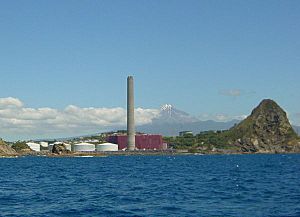New Plymouth Power Station facts for kids
Quick facts for kids New Plymouth Power Station |
|
|---|---|

NPPS from the sea
|
|
| Country | New Zealand |
| Location | Port Taranaki, New Plymouth, Taranaki |
| Coordinates | 39°03′28″S 174°01′38″E / 39.05778°S 174.02722°E |
| Status | Decommissioned |
| Commission date | 1974 |
| Decommission date | 2008 |
| Owner(s) | Port Taranaki |
The New Plymouth Power Station (NPPS) was a large thermal power station in New Plymouth, New Zealand. It could make 600 megawatts (MW) of electricity. Located at Port Taranaki, it was designed to run on two types of fuel: natural gas and fuel oil. This power station was New Zealand's first big thermal power plant built to run all the time, providing a steady supply of electricity.
Over the years, different companies owned and operated the power station. These included NZED, NZE, ECNZ, and Contact Energy. In 2013, the land where the power station stood was sold to Port Taranaki and another company called Methanex.
How the Power Station Started
Work on the New Plymouth Power Station began in the 1960s. New Zealand needed more electricity as the country grew.
Choosing the Location
At first, the plan was to use coal as fuel. This coal would be brought by barges from the West Coast. The site at Port Taranaki was chosen for the power station. It was picked over another possible location in Whanganui.
Changing the Fuel Source
While the project was still in its early stages, a big discovery was made. The Maui gas field was found off the coast of Taranaki. Because of this, the power station's design was changed. It was now built to use either natural gas or heavy fuel oil. This made it very flexible.
When it Started Running
The first part of the power station began making electricity in February 1974. By 1976, all five parts were working. For the first few years, the plant used gas from the Kapuni field. In 1979, it switched to gas from the Maui field after a new pipeline was finished. The old pipeline from Kapuni was then used to send Maui gas to other places.
Fuel Oil Use
The ability to use fuel oil was stopped in 1991. However, it was brought back in 2003. This meant the power station could again use either gas or oil.
Why it Ran Less Often
After 1999, the power station was used less often. This was because a newer, more efficient power station called Otahuhu started running. New Zealand gets most of its electricity from hydro power stations, which use water. This means the country's power supply depends a lot on rainfall. The New Plymouth Power Station was very important during dry years, like 1992, 2001, 2003, and 2008. In these years, there wasn't enough water for the hydro lakes, so the New Plymouth Power Station helped make up the difference.
Closing Down the Station
In 2007, Contact Energy, the company that owned the power station, found asbestos in the insulation. Asbestos is a material that can be dangerous. Because of this discovery, the company decided to close the power station.
In May 2008, one part of the station was temporarily started up again. It could make 100 MW of power. This was needed because there wasn't enough electricity across the country due to low water levels in the hydro lakes. This unit was finally shut down for good in December 2008.
What Happened to the Site
In 2013, most of the power station site was sold to Port Taranaki. The company Methanex bought a smaller part of the site where methanol tanks were located. In 2014 and 2015, the power station's equipment was taken out. The main building where the boilers were kept was also torn down. All the parts, pipes, and structures were sold as scrap metal.
How the Power Station Worked
The New Plymouth Power Station had five identical units. Each unit could produce 120 MW of electricity.
Main Parts
The large boilers, which heated water to make steam, were made by ICL in the UK. The steam turbines, which spun to create power, were made by C A Parsons, also from the UK.
Boilers and Steam
The boilers were designed to heat water very efficiently. Each boiler could produce 376 tonnes of steam every hour. This steam was extremely hot and under high pressure. It reached temperatures of 538 degrees Celsius and a pressure of 120 bar. The steam was then reheated to the same high temperature before going to the turbines.
Turbines and Generators
The steam turbines were designed to spin very fast, at 3000 rotations per minute. They had three main sections: high pressure, intermediate pressure, and low pressure. Seawater was used to cool the steam after it passed through the turbines. This cooling process turned the steam back into water so it could be reused. The generators, which actually made the electricity, were cooled by hydrogen gas.
Cooling System
A huge amount of seawater was used for cooling. Each unit needed 12,000 tonnes of seawater every hour to cool the steam.
The Tall Chimney
The power station had a very tall chimney, standing 198 meters high. It had five separate flues, which are like large pipes for smoke. This chimney is the second tallest structure in New Zealand.

